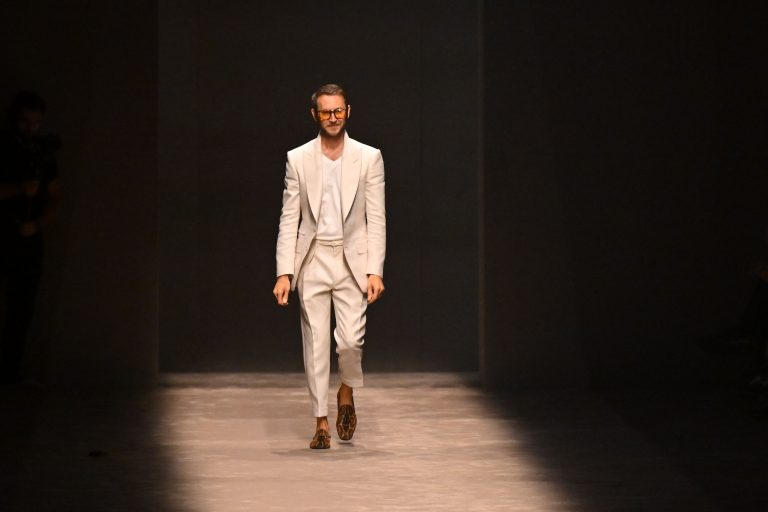As 2023 approaches, and after a year of industry-wide restructuring, the pace of change for the industry’s creative directors continues.
Last week, Peter Hawkings stepped down as creative director of Tom Ford for undisclosed reasons, after just one year at the helm of the brand. Hawkings was a likely successor after more than two decades at the helm, but during his brief tenure, the designer leaned heavily into celebrity marketing but failed to follow through on his vision.
The shocking news is the latest in a string of creative director departures this year: Matthew Williams left Givenchy in January, Pierpaolo Piccioli left Valentino in March, Dries Van Noten showed his final collection at his eponymous label in June, Virginie Viard left Chanel the same month, and there are also rumors that John Galliano might leave Maison Margiela for Dior.
Virginie Viard left Chanel earlier this year after five years. Image: Getty Images
Their absence also brings with it a growing list of new appointments in the luxury industry.
Lanvin announced last month that it had appointed British creative Peter Copping as its new artistic director as part of a major brand overhaul. Copping, who previously oversaw design at Oscar de la Renta and Nini Ricci before heading up couture at Balenciaga, faces the challenge of guiding Lanvin out of financial difficulties. He is due to take up the role in September.
More personnel changes within the Lanvin Group were revealed last week. Italian shoe and accessories brand Sergio Rossi appointed Paul Andrew as its new creative director on July 24, following the departure of artistic director Evangelie Smyrniotaki in June. Andrew, a former creative director at Ferragamo, will bring his deep shoe expertise to the Sergio Rossi label.
There have also been big changes in the C-suite: Fendi appointed Pierre-Emmanuel Angelo Groulx as its new CEO in March, and earlier this month Burberry replaced Jonathan Akerroyd with Joshua Schulman as CEO amid a steep drop in retail sales.
Peter Copping was appointed artistic director of Lanvin last month amid a major redesign of the brand. Image: Getty Images
The luxury industry’s recent upheaval may seem endless, but it’s emblematic of the industry today. Against a backdrop of economic uncertainty, geopolitical tensions and shifting consumer behavior, luxury fashion is in a period of turbulent transformation from which it is struggling to escape.
Those at the top are feeling the pressure: In a profit-driven market, newly appointed designers often don’t have time to develop their ideas before they face intense scrutiny from consumers, executives and shareholders.
Luxury consultant Daniel Langer analyzed the problems with this approach earlier this year: “Too many brands pin all their hopes on one person, then move on to the next with each passing season. But the danger here is that brands become overly dependent on the creative director and fail to provide a solid foundation for brand storytelling,” he wrote.
This is a particular problem at Gucci. Once buoyed by the star power of its former creative director, Alessandro Michele, the house has strategically tried to build a similar cult status around Michele’s successor, Sabato De Sarno. But it has failed. De Sarno, whose illustrious resume includes stints at Prada, Dolce & Gabbana, and Valentino, has struggled to generate the same buzz as Michele. And it shows in the numbers: Kering’s most recent earnings report showed that Gucci’s sales fell 20% year-over-year in the second quarter.
Lesser known designers like Gucci’s Sabato de Sarno have struggled to gain traction in the luxury industry. Image: Getty Images
The same can be said for a designer like Hawkings, whose debut collection at New York Fashion Week in September attempted to replicate the sexy, sensual silhouettes of his namesake designer, but ended up being a tepid repetition of past concepts. Ditto for Alexander McQueen, whose new creative director, Sean McGreer, can’t seem to find his footing, while debate rages over whether Sarah Burton (McGreer’s predecessor) will land roles at Chanel or Givenchy.
The lukewarm response to the industry’s newcomers has raised questions about the relevance of the creative director’s role in fashion today. As designer fatigue spreads, some fashion enthusiasts are calling for updating the industry’s outdated infrastructure to reflect today’s climate, such as by abolishing the role of creative director altogether or by giving the reins to women and people of color instead of white men.
This year is shaping up to be one of disruption across the luxury industry, and while many second-in-command talents, such as Chloe’s Chemena Kamali, are rising to the challenge, recent trends of short tenure point to an uncertain future for fashion. Will there be balance in 2025?


